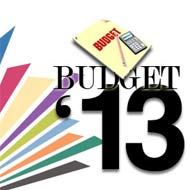The last budget before the country goes for general elections next year was all about fiscal prudence and lacked any big announcement.
The Finance Minister has delivered on one of the most important aspects in this Budget – fiscal consolidation. The budgeted fiscal deficit for FY2014 at 4.8 percent of GDP is in line with expectations. In terms of the fiscal deficit for FY2013, the Finance Minister has exceeded expectations and reined it at 5.2 percent and it is slightly lower than the government’s own estimate of 5.3 percent of GDP. In addition, the actual FY2012 headline deficit has also narrowed to 5.7 percent of GDP from 5.9 percent of GDP.
Overall, the FY2014 Budget is responsible and more credible since it seeks to narrow the fiscal deficit by increasing revenues as well as reprioritizing expenditure.
Although the Finance Minister has refrained from announcing any big bang reformist measures (as expected by the market) in the Budget, he has also abstained from ‘playing to the galleries’ and resorting to major populist policies ahead of the election year and that is a positive.
Balancing revenues and expenditure
The Finance Minister has calibrated fiscal policy towards a good growth mix. Non plan expenditure is expected to moderate to 9.8 percent of GDP in FY2014BE from the revised estimate of 10 percent of GDP in FY2013RE. Plan expenditure, on the other hand is expected to inch upwards to 4.9 percent of GDP in FY2014BE as compared to 4.3 percent of GDP in FY2013RE.
On the expenditure front, the government has clearly bitten the bullet. The total expenditure in FY2013RE is 4 percent lower than the FY2013BE and this has been achieved by squeezing plan expenditure during the period by 17.6 percent. However, for FY2014BE the Finance Minister has increased the allocation to plan expenditure by 29.4 percent (to Rs. 5.55 lakh crore) over FY2013RE.
On the revenue side, the budgeted estimates look optimistic particularly since buoyancy in revenues is linked to revival of economic activity. The Budget estimates a 21.2 percent rise in revenue receipts to Rs. 10.5 lakh crore over the revised estimates of FY2013 with a 35.8 percent rise in service tax in FY2014BE over FY2013RE as it has limited the services exempt from taxes.
The Budget also estimates a steep 74.6 percent rise in non debt capital receipts to Rs. 66,468 crore over the revised estimates of FY2013. This can be mainly attributed to upping of the disinvestment target to Rs. 40,000 crore in FY2014BE from Rs. 30,000 crore BE and Rs. 24,000 crore RE in the previous fiscal year. In addition, the Budget also seeks to divest government’s stake in non-PSUs to garner Rs. 14,000 crore. Overall, despite the over-estimation in receipts the fiscal deficit number looks credible.
The government would stick to its fiscal deficit target of 4.8 percent of GDP in FY2014 and akin to the previous fiscal year, any shortfall in revenues is likely to be offset by similar compression on the plan expenditure side.
It spells positively for the economy to avert a sovereign ratings downgrade by credit ratings agencies.
The narrowing of the fiscal deficit is also a positive for the interest rate environment in the economy as monetary policy is expected to adopt a more accommodative stance to support growth in the wake of fiscal consolidation by the government.
The budgeted subsidy burden for FY2014 is expected to decelerate to 2 percent of GDP as compared to FY2013RE of 2.6 percent of GDP and suggests a decline of 10.3 percent yoy. Food subsidy, a major component of the total subsidy, is estimated to rise by 5.9 percent in FY2014BE as against FY2013RE. The Finance Minister has set aside a moderate quantum of the subsidy (Rs. 10,000 crore) for implementing the National Food Security Bill in the run-up to the elections.
The rise in food subsidy bill is expected to be offset by holding a tight leash over fuel and petroleum subsidies. The 32.9 percent decline estimated in the petroleum subsidy for FY2014 over FY2013RE is not unrealistic since the government had set in place the momentum for reducing the petroleum subsidy since September 2012.
Tax proposals
The Finance Minister did not give any noteworthy relief to the tax payer except a nominal tax credit of Rs. 2,000 to persons with total income up to Rs. 5 lakh and additional deduction of Rs. 1 lakh on home loans below Rs. 25 lakh.
On the contrary, the surcharge on corporate tax, taking the effective tax rate to 34 percent, is expected to be negative for earnings estimates of companies. The increase in surcharge (from 5 percent to 10 percent) on dividend distribution tax taking it effectively to 17 percent from 16.25 percent is also a negative for the corporate sector.
In addition, the surcharge of 10 percent on persons whose taxable income exceeds Rs. 1crore per year is also sentimentally negative. The Finance Minister also proposed to increase the rate of tax on technical services to non-residents from 10 percent to 25percent. While the reduction in STT is positive for the markets, the levy of CTT on non-agricultural commodities futures contracts is a dampener.
One of the major reasons for the negative reaction in the markets after the budget was on account of the amendment to the requirements for claiming the benefit of DTAA (double taxation avoidance agreement). Furnishing of TRC (tax residency certificate) was made a necessary but not sufficient condition to qualify for the benefits. Moreover, this was made applicable retrospectively from FY2013. The finance minister post budget explained that the substance of the amendment was that not only residency but also beneficial ownership was necessary to claim the benefit under DTAA, which unnerved the market regarding transactions routed through tax haven Mauritius.
The misses
Exports: In addition to the rise in imports, weak export performance is also leading to a surge in the trade deficit of the economy and it widened to 10.8 percent of GDP during the first half of FY2013. In light of this, we were expecting a boost for the export-oriented sectors in the Budget. However in this regard, the Finance Minister refrained from providing sops to export related sectors and merely expressed optimism in the foreign trade policy to be announced next month.
Investment incentives: To encourage investments, the Budget has proposed a 15 percent investment allowance for new high value investments (Rs. 100cr or more) in plant and machinery and the Finance Minister also laid stress on ‘improving communication policy’ to ensure certainty to investors.
While these measures are sentimentally positive for the corporate sector, they are considerably lacking to revival of the capex cycle in the economy as the gross fixed capital formation rate has decelerated to 2.4% percent in FY2013 from 16.2 percent in FY2008.
Savings: The savings rate in the economy plummeted to 30.8 percent of GDP in FY2012 from its peak of 36.8 percent in FY2008.
The Budget increased the income eligibility limit for RGESS to Rs.12 lakh from Rs. 10 lakh, and provided an additional deduction of Rs. 1 lakh on home loans below Rs. 25lakh. Further, it suggested introduction of inflation-indexed bonds to augment the savings rate and attract households’ savings in financial assets as against nonproductive assets like physical gold.
Conclusion
The Finance Minister has delivered a budget that suggests economic stability supersedes political considerations. We regard it as a prudent but non-reformist budget. Despite the many misses, delivering on the fiscal deficit target is a key positive. It is crucial for averting a sovereign rating downgrade and thereby ensuring stability of capital flows to finance the current account deficit. Credibly lower fiscal deficit target for FY2014 is also expected to provide monetary policy with more headroom to ease policy rates and crowd in private sector investment. Going forward, maintaining the momentum on reforms beyond the Budget is pertinent to tackle structural supply side constraints in the economy, particularly in the mining and power sector, for revival of growth in the economy.































 +91 9909960054
+91 9909960054